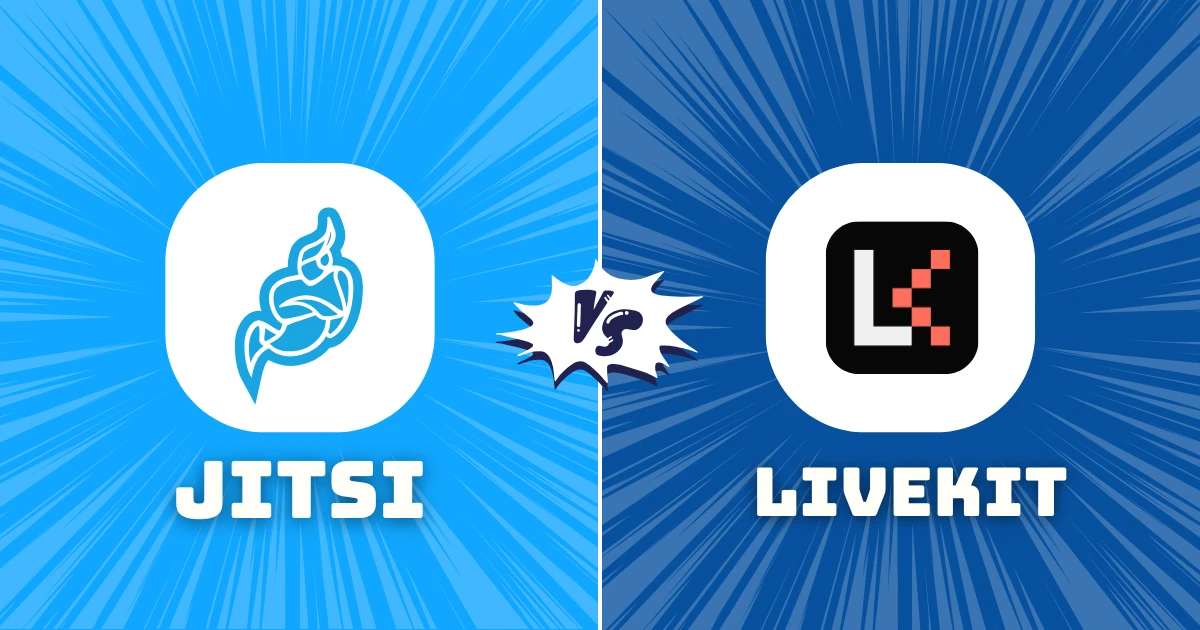Introduction
In today’s world, video communication has become essential for businesses, educators, and communities. When comparing Jitsi vs Livekit, it’s important to understand the differences in features, performance, and scalability. Both platforms are designed to offer real-time video and audio communication, but they serve slightly different purposes and audiences. In this article, we’ll dive deep into their strengths, weaknesses, and ideal use cases so you can make an informed choice.
What is Jitsi?
Jitsi is a free, open-source video conferencing platform known for its simplicity and privacy. It is widely used for online meetings, webinars, and small-scale video calls. Jitsi Meet, the most popular product, allows users to host meetings without creating an account or downloading complex software.
Key Features of Jitsi
- Open Source: Fully open-source, allowing complete customization.
- No Account Needed: Users can join instantly via a link.
- End-to-End Encryption: Offers secure communication for sensitive discussions.
- Screen Sharing and Recording: Includes options for presenting and documenting meetings.
- Cross-Platform Support: Works on Windows, Mac, Linux, Android, and iOS.
Pros of Jitsi
- Free and open-source
- Easy setup and use
- Strong privacy features
- Good for small teams or organizations
Cons of Jitsi
- Performance may drop with large meetings
- Limited built-in integrations
- Requires technical knowledge for advanced customization
What is Livekit?
Livekit is an open-source platform focused on real-time audio and video streaming. Unlike Jitsi, Livekit is designed more for developers and businesses who want to integrate video functionality directly into their apps or websites.
Key Features of Livekit
- Customizable SDKs: Offers SDKs for web, mobile, and desktop apps.
- High Performance: Designed for scalable video and audio streaming.
- Low Latency: Optimized for real-time applications like live events and games.
- Open Source: Free to use and modify for custom solutions.
- Flexible Infrastructure: Can be self-hosted or used with managed cloud services.
Pros of Livekit
- High scalability for large audiences
- Low-latency streaming for interactive apps
- Developer-friendly APIs and SDKs
- Works well for enterprise-grade solutions
Cons of Livekit
- Requires development knowledge for integration
- Not a ready-to-use video conferencing app
- Initial setup can be complex
Jitsi vs Livekit: Feature Comparison
| Feature | Jitsi Meet | Livekit |
|---|---|---|
| Target Audience | General users, small teams | Developers, enterprises |
| Open Source | Yes | Yes |
| Ease of Use | Very easy | Moderate (requires coding) |
| Scalability | Up to 50 participants comfortably | Hundreds or thousands of participants |
| Customization | Limited to UI tweaks | Full customization via SDKs |
| Mobile Support | Android & iOS apps available | SDK support for Android & iOS |
| Hosting Options | Self-hosted or Jitsi.org cloud | Self-hosted or cloud services |
| Security | End-to-end encryption | Depends on implementation |
| Recording | Yes (server-based) | Custom integration required |
| Latency | Low for small groups | Very low, optimized for real-time |
Use Cases: When to Choose Jitsi
- Small Team Meetings: Perfect for quick team calls without sign-ups.
- Educational Classes: Easy for teachers and students to join instantly.
- Privacy-Focused Discussions: Offers end-to-end encryption for sensitive topics.
- Non-Technical Users: Minimal setup makes it ideal for anyone.
Use Cases: When to Choose Livekit
- Interactive Apps: Games, webinars, and live streaming apps benefit from low latency.
- Large-Scale Events: Designed for hundreds or thousands of participants.
- Custom Integrations: Perfect for businesses embedding video into their platforms.
- Developer Projects: Full SDKs allow deep customization and control.
Performance and Scalability
Jitsi works best for smaller meetings (up to 50 participants) and may require extra resources for larger groups. Livekit, on the other hand, is built for high performance and can handle large audiences with minimal latency.
Key Takeaway
If you need a simple, ready-to-use conferencing tool, Jitsi is ideal. If you are building a platform that requires scalable real-time communication, Livekit is the better choice.
Security and Privacy
Both platforms are open source, which means transparency in their code. Jitsi offers end-to-end encryption, making it a strong choice for privacy-focused users. Livekit’s security depends on how it is implemented, giving developers flexibility but also responsibility.
Integration and Customization
- Jitsi: Limited customization primarily UI branding and minor plugins.
- Livekit: Full customization through SDKs, allowing developers to integrate video features into any app or service.
Cost Comparison
- Jitsi: Free for self-hosting; optional paid plans for hosted services.
- Livekit: Free open-source SDKs; hosting may incur costs depending on traffic and cloud usage.
Conclusion
Choosing between Jitsi vs Livekit ultimately depends on your needs. For quick, privacy-focused video calls without coding, Jitsi is the best choice. If you are a developer or business seeking a scalable, customizable video solution, Livekit provides the tools and flexibility needed.
Got questions or need help setting up Jitsi? Contact us — we provide expert Jitsi installation, scaling, and customization services.
